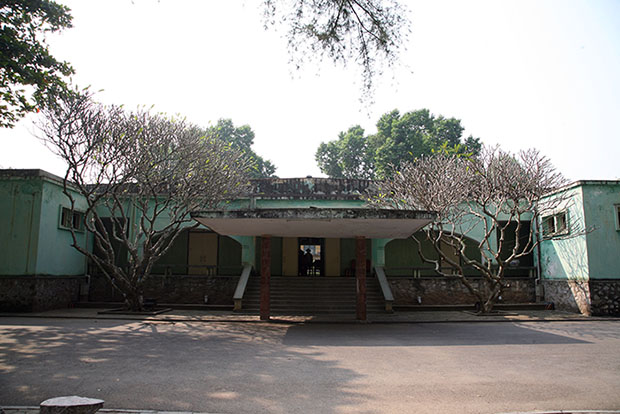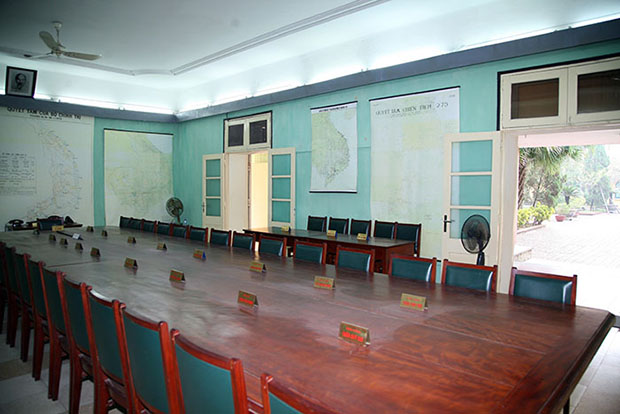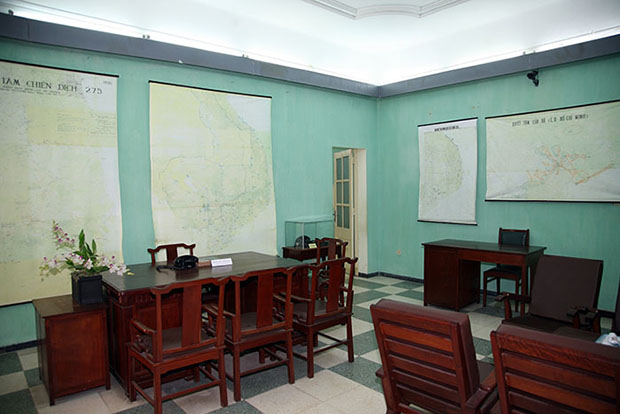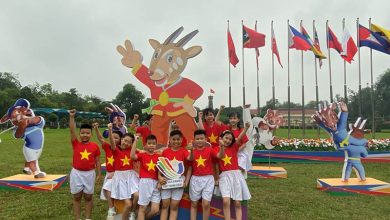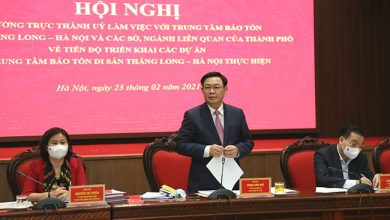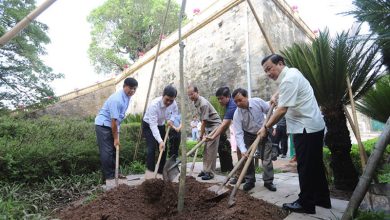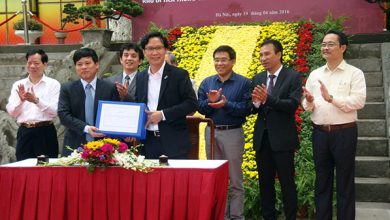Building D67, a revolutionary relic typical of the Ho Chi Minh era
The Thăng Long Imperial Citadel was inscribed on UNESCO’s List of World Heritage in 2010. The site boasts a history of over 1,000 years spanning all the way from the time of King Lý Thái Tổ to the glorious history of modern Vietnam founded by Hồ Chí Minh. The site coincides with the Forbidden City of the Thăng Long Citadel across the consecutive dynasties of Lý, Trần and Lê. It was also a provincial capital under the Nguyễn dynasty, and the headquarters of Vietnam’s Ministry of Defence during the American War. The relics within the site are of paramount significance to the education of history and traditions to the general public, especially young generations. Among these relics are Building D67 and the bunker of the same name where some of the most important meetings of the Politburo and the Central Military Commission took place during the Second Indochina War.
Building D67 – a revolutionary relic
Building D67, as the name suggests, was constructed in 1967. It is a one-storey building with an area of 604.41 square metres, about 30m to the back of the Dragon House. The building was made of solid and bulk concrete and steel. The outer wall was 0.60m thick while the dividing wall was 0.28m thick. The roof featured three layers. The ceiling was 0.15m thick; a buffer middle layer of sand about 0.7 and 1.15m thick while the upper layer was 0.35m thick. At the centre was the meeting room of the Politburo and the Central Military Commission (about 76 square metres). Adjacent to it was a lounge about 37 square metres in area. The small room to the east, which covered 35 square metres, was the work place of General Giáp while the small room of the same size to the west was the work place of General Văn Tiến Dũng. From Building D67 there were two stairs connecting directly to Bunker D67 (also known as the Central Military Commission Bunker).
Building D67 was associated with the day-to-day operation of the Politburo, the Central Military Commission, the Minister of Defence, the General Chief of Staff of the People’s Army of Vietnam. It was here that between September 1968 and 30 April 1975 the top-tiered leadership including the Politburo of Vietnam’s Labour Party (known after 1976 as the Communist Party of Vietnam), the Central Military Commission, and the General Command of the People’s Army issued sensible and creative policies and strategies to lead the entire nation to final victory against the Americans.
In January 1971, the Politburo and the Central Military Commission met to decide on the launch of a large-scale counterattack against the Operation Lam Son 719 to kill the enemies.
On 30 January 1974, the Politburo had an extended meeting to discuss the capture of opportunities to accelerate the revolutionary movement in the South.
On 30 September 1974, the Politburo and the Central Military Commission met to agree on the approval of the 7th draft of the basic strategic plan prepared by the General Staff. The meeting highlighted the necessity and importance of a plan to create and capture opportunities. Under no circumstances should any strategic opportunities be missed. “If opportunity presents itself at the beginning or end of 1975, it is imperative to liberate the South in the same year”. And the Central Highlands, known as Tây Nguyên, was chosen as the major battlefield in the extensive general offensive in 1975.
The meeting room of the Politburo and the Central Military Commission
On 18 December 1974, the extended meeting of the Politburo commenced in Building D67 to discuss plans and demonstrated strong will to liberate the South for national reunification. The meeting concluded on 8 January 1975 and a resolution was consequently issued: “We are having enormous strategic opportunity. Never before have we been so well-equipped militarily and politically to complete the cause of a democratic and popular revolution in the South and prepare for national reunification”. The Politburo was determined to: “mobilize utmost efforts from the Party, the army and the people from both the North and the South between 1975- 1976, step up military and political struggle in combination with diplomatic struggle to bring about quick, radical changes in the balance of power of the forces fighting the southern battleground in our favour, make every necessary preparation, create all ripe conditions, stage offensive to kill and disperse the Sothern regime’s army, topple its government from both central to local level to transfer to the hands of the people, and liberate the South.”
Talking about this event, General Giap recounted in his memoir titled “The General Headquarters during the Victorious Spring Days”: “The building hidden among the thick foliage of the trees with solid bunkers where some of the top secret meetings of the Politburo and the Central Military Commission today again witnesses a historical event which is of decisive significance. The will and intelligence of the Party is demonstrated in utmost form to discuss plans for total victory”.
General Võ Nguyên Giáp’s Office
Right after the conclusion of the Politburo’s extended meeting, on 9 January 1975, the Central Military Commission met to implement the resolution of the Poliburo. This meeting reassert that the target of attack would be the Central Highlands, particularly Buôn Mê Thuột.
On 24 March 1975, the Politburo and the Central Military Commission met to assert that conditions had never been so ripe and opportunity never so great during the past 20 years. The general offensive started with the Central Highlands (Tây Nguyên) Campaign. Grabbing the opportunity and acting quickly, boldly, unpredictably to stun the enemy will help us liberate Sài Gòn before the rainy season.
On 31 March 1975 the Politburo of the Central Party Committee met again. This was a historic meeting because it discussed the third strategy, the last blow of the general offensive and uprising. According to the Politburo’s analysis, “our country’s revolution is developing at a pace of one day equaling 20 years. Therefore, the Politburo decides to grab the strategic opportunity to instruct the army to advance at full speed, delivering bold, unpredictable but well-prepared blows, trying to stage an offensive and uprising in the earliest possible time, preferable in April” (Excerpt from the Politburo’s Resolution on 31 March 1975). The Party’s resolve was soon materialized from the frontline to the rear. Everywhere in the battleground, the morale of the army was thunder-like, advancing unstoppably. On 7 April1975, General Võ Nguyên Giáp sent a military order to the whole army, which read: “Advance more quickly and boldly; taking advantage of every minute and hour to rush to the front to liberate the South for total final victory”.
On the morning of 29 and 30 April 1975, the headquarters was full of joy and laughter. The Politburo and the Central Military Commission followed with great attention every development of the general offensive and uprising, discussing issues and preparing to celebrate victory.
Since 2 May 1975 onwards, the Central Military Commission also held several meetings in Building D67 to discuss the development of force and strategies of protecting the Socialist government amidst fresh challenges and new situations.
More than 40 years have passed. Building D67 has now become an extremely important revolutionary relic within the heritage site of Thăng Long Imperial Citadel. Today’s visitors to Building D67 will be moved to see with their own eyes the pictures and objects of the commanding headquarters in the past, the workplace of the top military leaders who were the masterminds of the resistance war against American imperialism for national salvation. Each map, chair, phone set, etc. in the building helps to remind us of not only a hard time, difficult chapter but also the victorious moments of the national history.
Kim Yến
Thăng Long – Hà Nội Heritage Conservation Centre

